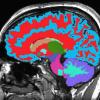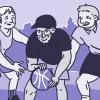Search

Home Test Kits Boost Screening for Cervical Cancer
Cervical cancer can be easy to miss. It usually has no symptoms. But you can have a screening test for the virus that causes nearly all cases of cervical cancer. The tests detect human papilloma virus, or HPV. Early diagnosis and treatment can prevent cervical cancer and related deaths. Unfortunately, many women have never been screened or are behind in their screening. NIH-supported scientists…

What Are Omega-3s?
Your body needs omega-3 fatty acids, sometimes called “omega-3s,” to stay healthy. These help to build brain cells and keep your heart and other organs in good working order. Your body can’t make omega-3s itself. They come from the foods you eat or dietary supplements. Fatty fish, like salmon and tuna, are rich in types of omega-3s called DHA and EPA. These healthy fats are also found in…

Kids Environment, Kids Health
Have fun learning about health, science, and the world we live in. Kids, parents, and teachers can find engaging and educational information at this NIH website. Solve puzzles, play games, and learn about the environment we all share. See how you can make a difference.

Tension Headaches, Migraine, and More
Headaches come in many forms. Where you feel the pain, what other symptoms you have, and how long headaches last can vary. For many people, headaches are an occasional nuisance. For others, they can be chronic and disabling. Some headaches can be prevented with small lifestyle changes. Drinking enough water, avoiding headache triggers, managing stress, or improving sleep can sometimes be enough.…, Types of Headaches, There are many types of headaches. Understanding the type you’re having can help you find the right treatment. The most common is called a tension-type headache. These are often triggered by stress, which causes muscles in the neck, face, scalp, and jaw to tighten. Lack of sleep, dehydration, and poor posture can also lead to a tension-type headache. The pain from a tension-type headache is…, Trying Treatments, You can help take control of your headaches by keeping a headache diary. Track your symptoms, how often they happen, and what alleviates them. “For at least a month, just note down when you have a headache, how you treated it, how long it lasted,” Oshinsky says. You can also include facts like foods or drinks consumed, sleep patterns, stress levels, and changes in daily routines. This can help…, Small Heads, Big Aches, Headaches are common in kids, too. Often, headaches in children and teens can be treated by drinking more water, having a healthier diet, getting enough activity, and solving sleep problems. Always talk to a doctor before giving headache medicines to a child. Sometimes, it can be difficult to figure out what kind of pain a child is feeling. “A very young child with a migraine headache will often…

Probing Aspirin’s Benefits
You’ve probably taken aspirin for pain or a fever. But some people take a low dose of aspirin every day. It can reduce the risk of [qtip:cardiovascular|Related to the heart and the vessels that circulate blood through the body.] events like heart attacks and strokes. Now, scientists are learning that aspirin’s effects differ based on a person’s age and overall health. Aspirin helps prevent heart…

Brain Scan Measures Aging Rate
Biologically speaking, some people age faster than others. Your aging rate can affect your health and disease risks. If you knew this rate, you might be able to work with your doctor to slow the aging process. A research team developed a way to measure aging based on a single brain scan. The team drew on their earlier studies, where they devised a way to measure biological aging using blood tests…

What Is Barrett’s Esophagus?
A condition called Barrett’s esophagus affects about 5% of adults nationwide. It causes the lining of the esophagus, the tube that carries food from your mouth to your stomach, to change. This raises the risk for getting cancer of the esophagus. Doctors don’t yet know what causes Barrett’s esophagus. But some people are at increased risk. The condition is more common in the U.S. than in other…

Sickle Cell Awareness
Sickle cell disease is the most common inherited blood disorder in the U.S. It affects about 100,000 Americans. Get tips for managing the disease and creating a healthy lifestyle. Learn about treatments. Read inspiring stories from people living with sickle cell disease.

Tendon Trouble
Tendons connect muscles to bones. Without them, your muscles couldn’t move your body. When you injure a tendon, it can affect your everyday activities. “No matter how strong your muscle is, you’re not going to be able to have the functionality and the stability that you need if a tendon is impaired,” says Dr. Nelly Andarawis-Puri, a bioengineering researcher at Cornell University. Tendon troubles…, Breaking the Cycle, “The most common type of tendon injury is an overuse, or wear-and-tear, injury,” explains Andarawis-Puri. “It’s not necessarily painful once it starts and can be silent for a long time. Essentially, you predispose yourself to more and more accumulation of damage. Then, eventually you have degeneration.” Getting treatment early can help keep tendon problems from getting worse. Your doctor may…, Reversing Chronic Conditions, The highly organized nature of tendons is key for them to work properly. “But tendons are a rather lazy organ,” Abraham explains. “They are slow to adapt, if they adapt at all.” Abraham’s team is trying to understand the changes tendons undergo from chronic injuries. They’ve developed a system that allows them to grow 3D tendon-like structures using cells from patients’ tendons. “We’re developing…, Coaxing Repair, Unlike people, some animals can fully repair tendon tissue as adults. For instance, zebrafish completely regenerate tendons throughout their lives. Galloway hopes to learn from them. Her group has shown that tenocytes can repair fully torn tendon tissue in zebrafish. Her recent study showed that the cells bridge fully severed tissue back together. People and other mammals have tenocytes, too. But…

Getting a Grip on Gastroparesis
After you eat, your stomach breaks down the food before pushing it along. How long it takes for your stomach to empty depends on many factors. Meals that are big, fatty, or high in calories will empty more slowly, but it also depends on your health. Some people have a condition that makes food empty slower than it should. It’s called gastroparesis. Gastroparesis isn’t common. But about 1 in 4…
NIH Office of Communications and Public Liaison
Health and Science Publications Branch
Building 31, Room 5B52
Bethesda, MD 20892-2094
Contact Us:
nihnewsinhealth@od.nih.gov
Phone: 301-451-8224
Share Our Materials: Reprint our articles and illustrations in your own publication. Our material is not copyrighted. Please acknowledge NIH News in Health as the source and send us a copy.
For more consumer health news and information, visit health.nih.gov.
For wellness toolkits, visit www.nih.gov/wellnesstoolkits.
